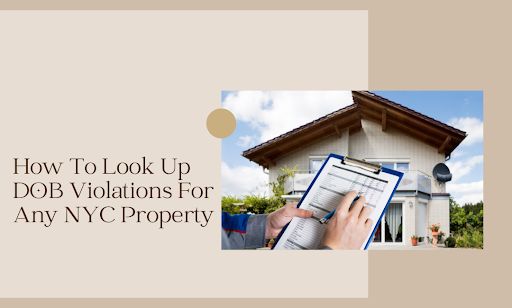Why do so many property owners get blindsided by NYC building violations? They assume a mailed notice will give them enough time to react. It doesn’t. By the time that letter arrives, deadlines are already shrinking, fines are climbing, and stress is mounting.
Here’s the truth: you can check for DOB violations long before problems spiral. You don’t need to wait on paperwork, phone calls, or outdated records. The tools exist—if you know where to look.
This article walks you through three fast, reliable ways to look up DOB violations for any NYC property:
- Online Building Information System (BIS) — The city’s long-standing platform for property and violation records.
- DOB NOW Public Portal — A newer, more detailed system with direct access to filings and updates.
- Private tools — Aggregators that pull data from multiple agencies for faster, more convenient searches.
By the end, you’ll know exactly where to go, what information to grab, and how to stay ahead of violation deadlines before they cost you real money.
Online Building Information System for DOB Violations
The Building Information System (BIS) is the oldest and most widely used platform for accessing New York City property records, including DOB violations. It remains a reliable source for professionals who need immediate access to property compliance details without sifting through multiple channels.
BIS offers straightforward search options and public access, making it useful for everything from initial property reviews to ongoing compliance checks. Here’s how to use it effectively.
Key Functions Available in BIS
The Building Information System (BIS) remains the primary platform for public access to NYC property records, including Department of Buildings (DOB) violations. It serves multiple functions beyond basic violation lookups, giving professionals access to extensive compliance data.
Within BIS, you can:
- View DOB and ECB violations: The system clearly shows whether violations are open, resolved, or dismissed. Open DOB violations display without an asterisk; resolved or dismissed violations display with one.
- Access property profiles: This includes address, borough, block and lot, ownership details, certificates of occupancy, and zoning information.
- Check permit and job filing history: You can see active, expired, or pending permits and jobs, providing context for violations triggered by unpermitted work.
- Review complaint and inspection records: Prior complaints and inspection logs appear here, often linked to violation issuance.
- Identify issuing units: The system indicates which DOB division issued the violation, helping you determine the right channel for resolution or document requests.
This step-by-step guide makes BIS a foundational tool for compliance professionals handling violation research across multiple properties.
Steps to Look Up DOB Violations in BIS
Searching BIS for DOB violations follows a structured process to ensure accurate results. This guide gives you the sequence professionals use to avoid errors:
- Collect property identifiers first: Use the borough, block, and lot number, or full property address. Block and lot numbers are preferred because they remain consistent even if street addresses change.
- Access the BIS property search page: Enter the property information and run the search. Multiple properties may appear—select the correct profile based on both address and block and lot details.
- Open the property profile: Within the profile, you’ll find tabs for permits, inspections, complaints, and violations. Navigate to the “Violations” section.
- Review violation details: Each violation includes its issuance date, issuing unit, description, and current status. Open violations appear without an asterisk; resolved or dismissed ones display with an asterisk next to the violation number.
- Document key information: Record violation numbers, dates, and responsible DOB units. This information is required for follow-up actions, corrections, or hearing preparation.
Following this process ensures you gather every relevant detail for compliance planning, preventing failure to act on time.
Pro Tips for BIS Searches
To increase search accuracy and avoid common errors, apply these practices when using BIS:
- Always use block and lot numbers when available—they reduce the risk of selecting the wrong property.
- Cross-check the issuing unit for each violation; certain divisions require specific documentation or correction filings.
- Review both complaints and permit history alongside violations. Some violations originate from unresolved complaints or expired permits, which may also need action.
- When violation details are incomplete online, submit a document request directly to the issuing unit or through a Freedom of Information Law (FOIL) request.
- For violations tied to Local Laws—like boiler, façade, or elevator issues—confirm whether additional technical reports or engineering certifications are required for resolution.
Used correctly, BIS gives you a complete view of a property’s compliance status and helps you plan the next steps efficiently. For many professionals, the types of data available here remain one of the most important additions to NYC property management workflows, especially for selling or refinancing buildings where violations raise tough questions during transactions.
DOB NOW Public Portal for Violation Lookups

The DOB NOW Public Portal serves as NYC’s modernized platform for property compliance, filings, permits, and violation data. Unlike the older BIS system, this portal links directly to active filings, inspection updates, and enforcement records maintained by the Department of Buildings.
For professionals handling multiple properties, it offers a more structured way to track violations alongside real-time project data.
Functions Available in the DOB NOW Public Portal
The portal combines violation lookups with broader project management features. Its most frequently used functions include:
- Direct Access to Violations: View open, dismissed, or resolved violations tied to a property, including hearing outcomes and correction requirements.
- Permit and Filing Integration: See whether a violation connects to unfiled, pending, or rejected permits and view the related documentation.
- Inspection and Enforcement Records: Access inspection results that led to violation issuance or status changes.
- Hearing Schedules and Outcomes: Track upcoming hearings or review past hearing dispositions when violations reach the Office of Administrative Trials and Hearings (OATH).
- Real-Time Updates: Receive the latest status changes when enforcement actions, inspections, or corrections occur.
By offering these functions, the portal creates a single location where all compliance actions related to violations, permits, and hearings align with official DOB records.
Steps by Step Guide To Look Up DOB Violations in the Public Portal
The process requires precise property information to avoid incomplete or inaccurate results.
- Open the DOB NOW Public Portal using the official link provided by the NYC Department of Buildings.
- Enter property identifiers such as the borough, block, and lot number, or address. For large portfolios, block and lot numbers remain the most reliable option.
- Select the property profile from the results to access all compliance-related records.
- Navigate to the Violations section, where open and resolved violations appear along with associated inspection records.
- Check hearing schedules and outcomes if violations escalated to OATH. These details appear in the same violation record.
- Download or save violation details for internal compliance tracking or coordination with legal or engineering professionals handling corrections.
Each step provides progressively deeper access to records, ensuring no part of the violation history gets overlooked.
Pro Tips for Public Portal Searches
Accuracy and efficiency depend on understanding how the portal organizes data:
- Verify property identifiers before running searches to avoid mismatched profiles or incomplete records.
- Review both the violation and filing tabs because unresolved permits often delay violation closure.
- Monitor OATH outcomes for violations requiring hearings, as penalty reductions or dismissals appear here first.
- Download enforcement and inspection reports when available; they provide documentation required for appeals or correction certifications.
- Check for repeated violations on the same property feature—such as fire safety systems or structural elements—which often signal deeper compliance issues needing permanent resolution.
When used correctly, the DOB NOW Public Portal becomes a precise, time-saving resource for managing property violations from issuance through resolution.
Private Tools for Faster Violation Lookups

Many professionals turn to third-party tools like PropertyShark, NYC Open Data, or WhoOwnsWhat when searching for DOB violations. These platforms provide basic property and permit data but fall short when speed, accuracy, and coverage across multiple agencies matter most.
Some even miss critical records such as fire safety violations, which can quickly escalate into costly penalties if left unresolved.
Why Traditional Tools Leave Gaps
Older systems require you to:
- Manually check for new violations.
- Search agency by agency, often missing HPD, FDNY, or DSNY records, and even environmental control board updates.
- Work with data that sometimes updates days after the violation is posted.
The result? Late discovery, rushed corrections, and penalties that keep growing while information slowly filters through. These gaps make it harder to stay compliant with NYC rules and increase the risk of missed deadlines.
How ViolationWatch Changes the Process
ViolationWatch eliminates the delays and manual effort common with older tools. The platform connects directly to DOB, FDNY, HPD, 311, DEP, DSNY, ECB, and more—giving you the most current data available.
Here’s how it works for violation lookups:
- Real-time monitoring across all major NYC agencies, the moment violations appear online.
- Unified dashboard where every open, dismissed, or resolved violation is organized by property.
- Instant notifications via email, SMS, or WhatsApp so your team sees updates immediately.
- AI-powered scanning to prevent missed violations across multiple properties.
- Hearing schedules and outcomes are linked directly to each violation record for easier resolution planning.
Instead of searching multiple portals or relying on outdated feeds, ViolationWatch keeps all violation activity centralized, real-time, and actionable.
How ViolationWatch Handles DOB Violation Lookups
Instead of constant manual searches, ViolationWatch streamlines the process from start to finish. Here’s how it works when looking up DOB violations for any NYC property:
- Add your properties once — The platform stores them, so you don’t have to repeat searches for each address.

- Automatic violation detection — As soon as DOB or other agencies post a violation, it appears in your dashboard instantly.

- Centralized records for every property — Open, dismissed, or resolved violations from multiple agencies stay organized in one place.

- Deadline visibility and alerts — You see key dates early enough to plan corrections before penalties grow.

For professionals handling construction projects or refinancing applications, this level of visibility is critical. DOB penalties in NYC can run thousands of dollars per violation, especially when deadlines for correction or hearings slip by unnoticed.
ViolationWatch costs $9.99 per address per month—a fraction of even a single fine. That small, predictable expense replaces the risk of scrambling after surprise penalties. It turns violation management into a proactive, controlled process instead of a race against the clock, giving property teams the property profile overview they need to comply with NYC requirements confidently.
Keep NYC DOB Violations Under Control
NYC violations carry weight. One missed DOB notice can snowball into hearing dates, penalties, and mounting stress. You’ve now seen three ways to look up violations — the BIS system, the DOB NOW Public Portal, and private tools like ViolationWatch.
The first two require manual effort, constant monitoring, and time you rarely have. ViolationWatch automates it all. For $9.99 per address each month, you get instant alerts, a single dashboard for every property, and enough lead time to act before fines escalate.
Managing violations shouldn’t drain your schedule or your budget. With the right tool, you prevent costly mistakes, stay ahead of deadlines, and focus on running your properties instead of reacting to penalties.

